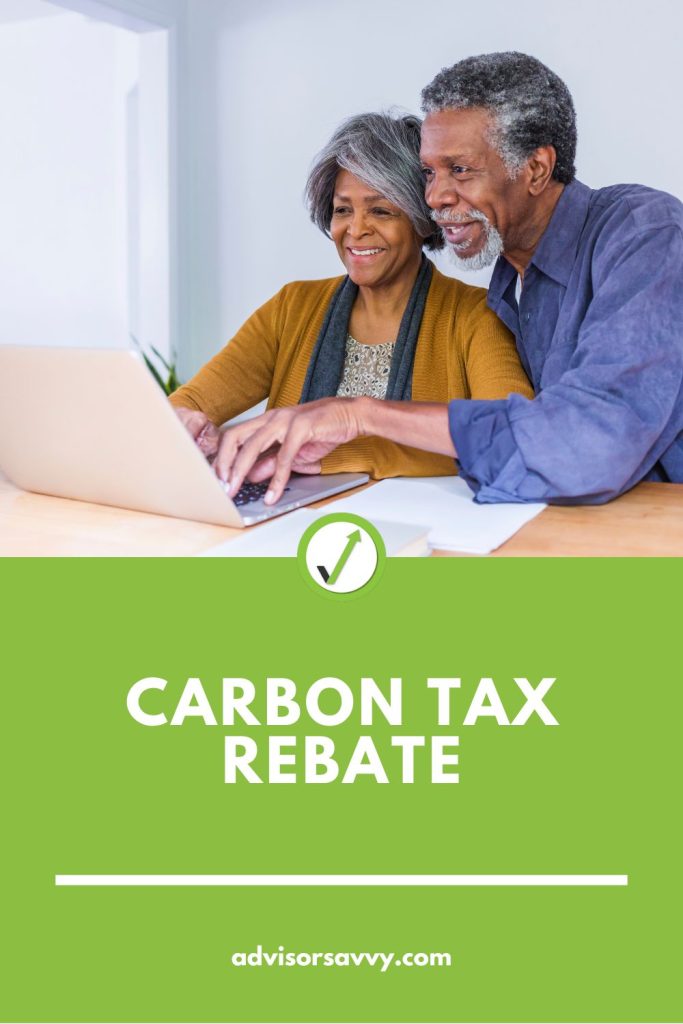
In Canada, we’re fortunate to have access to an array of benefits. One of these benefits is the carbon tax rebate, better known as the climate action incentive payment. This program originally started as a tax credit that could be claimed on your tax return, but became a tax free payment a few years ago. In this article, we’ll cover all the details of the carbon tax rebate, including eligibility, payment amounts, and how to claim the benefit. Continuing reading to learn more!

Table of contents
What is the carbon tax rebate?
The carbon tax rebate is a benefit available to Canadians in certain provinces and territories. It is more commonly known as the climate action incentive payment, or CAIP for short. The program offers a tax free payment to individuals and families to offset the cost of federal pollution pricing. It is paid quarterly and enrollment is typically automatic. If you received a strange deposit to your bank account recently from the Canada Revenue Agency, it’s likely the carbon tax rebate!
CIBC Investor’s Line Offer
Up to $6.95 per online stock or ETF trade. Plus, there’s no minimum account balance.
Who is eligible for the carbon tax rebate?
At the time of writing, the carbon tax rebate isn’t available to every Canadian. It’s only provided to residents of Alberta, Saskatchewan, Manitoba, and Ontario. Starting in July 2023, residents of Newfoundland and Labrador, Nova Scotia, and Prince Edward Island will also become eligible. As of July 1, 2023, the federal fuel charge will apply to these provinces which is why they will begin receiving the rebate.
In addition to your province or territory of residence, you must be at least 19 years of age to be eligible for this program. If you have children and/or a spouse or common-law partner, you will receive an additional payment. But with that in mind, single individuals with no children are still eligible for the basic amount.
Lastly, the following people are generally not eligible for the carbon tax rebate, if any of the following apply:
- You are not a resident of Canada for income tax purposes
- You do not pay tax in Canada due to being an officer or servant of another country, or a relative of such a person
- You are incarcerated for at least 90 consecutive days
Does everyone get the carbon tax rebate?
At present, no, not every Canadian gets the carbon tax rebate. The payment is exclusively available to provinces and territories who are subject to federal pollution pricing. This is because the payment offsets the federal pollution pricing costs that trickle down to Canadian’s wallets.
Only residents of Ontario, Manitoba, Alberta, and Saskatchewan receive the benefit at this time. Starting July 1, 2023, residents of Nova Scotia, Prince Edward Island, and Newfoundland and Labrador will receive the benefit as well.
In addition, you must be a Canadian resident and at least 19 years of age to be eligible for the carbon tax rebate. Those who have children, a common-law partner, and/or a spouse are eligible to receive a higher amount than their single, childless counterparts.
Related Reading: What is a Bank Draft in Canada?
CIBC Investor’s Line Offer
Up to $6.95 per online stock or ETF trade. Plus, there’s no minimum account balance.
How much is the carbon tax rebate?
Below is the amount you can expect to receive from the carbon tax rebate program based on your province or territory of residence and personal circumstances:
| Carbon Tax Rebate Payments | Alberta | Manitoba | Ontario | Saskatchewan | Newfoundland & Labrador* | Nova Scotia* | Prince Edward Island* |
| Individual/Base | $193 | $132 | $122 | $170 | $164 | $124 | $120 |
| Spouse/Common-Law Partner | $96.50 | $66 | $61 | $85 | $82 | $62 | $60 |
| First Child in Single-Parent Family | $96.50 | $66 | $61 | $85 | $82 | $62 | $60 |
| Each Child under 19 Years of Age | $48.25 | $33 | $30.50 | $42.50 | $41 | $31 | $30 |
Small, rural areas of Canada receive an additional 10% supplement on top of the base amount. The only exception is Prince Edward Island. The entire province is considered to be rural so the payment already includes the 10% supplement.
Payments are made to residents of Canada on a quarterly basis. The above amounts reflect how much you can expect to receive, plus a little more if you’re eligible for the 10% supplement and not a resident of Prince Edward Island. Below are the payment dates:
- January 1, 2023
- April 1, 2023
- July 1, 2023
- October 1, 2023
Is carbon tax rebate based on income?
No, the carbon tax rebate isn’t based on income. Rather, it’s based on your province and territory of residence and whether that region is subject to federal pollution pricing. In addition, residency and being the age of majority, 19, is also considered for eligibility purposes.
How much will the carbon tax rebate be in 2023?
In 2023, the base amount is between $120 and $193, depending on where you live in Canada. If you have a spouse or common-law partner, you will receive an additional $60 to $96.50, based on your province or territory of residence. For the first child in a single parent household, you’ll receive between $60 and $96.50. Finally, you’ll receive $30 to $48.25 for every child under the age of 19 years. If you live in a rural community, you’ll receive an additional 10% supplement, except for residents of Prince Edward Island because the 10% gross up is already reflected in the amounts. Refer to the table above for more details. Also note that these figures are the quarterly amounts, not annual.
Related Reading: Tax Credit vs Tax Deduction in Canada
Why didn’t I get my carbon tax rebate?
If you didn’t receive your rebate, double check the eligibility criteria. There is a possibility that you’re not eligible which is why you didn’t receive it.
If you’re sure you’re eligible for the carbon tax rebate, the most likely reason you didn’t receive your payment is because you didn’t file your annual tax return. The CRA automatically assesses eligibility based on your income tax return. Make sure to tick the box on page 2 on your tax return if you live in a rural community to get the additional 10% supplement. Lastly, both you and your spouse or common-law partner need to file to claim the additional amount. Also, be sure to disclose any dependents on your tax return to ensure you receive the rebate for children.
If you have filed your tax return and still haven’t received your carbon tax rebate, reach out to the Canada Revenue Agency to inquire.
Related Reading: GST/HST Credit: A Complete Guide
Claiming the Carbon Tax Rebate
The carbon tax rebate is a broad benefit available to many Canadians. Keep an eye out for the payment in your bank account or a cheque in the mail each January, April, July and October to ensure you receive the claim. In addition, make sure to file your annual tax return each year to continue receiving the benefit, plus others.
Do you need help navigating the carbon tax rebate or filing your annual tax return to claim the benefit? A financial advisor can help! Fill out this quick questionnaire and Advisorsavvy will find your perfect match.
Read More: When Does OAS Change to Age 67?

Match to your perfect advisor now.
Getting started is easy, fast and free.

